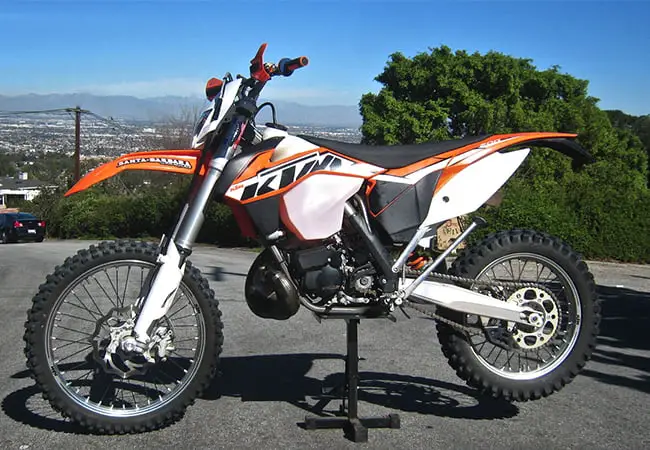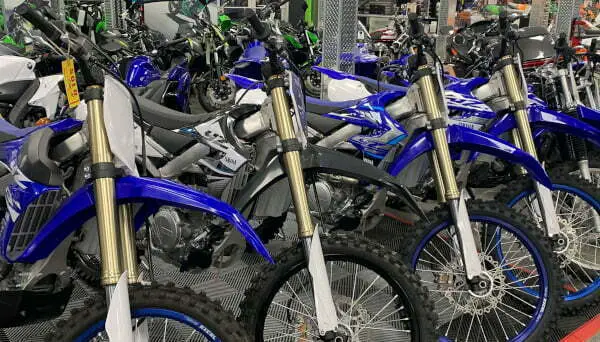Recently I spent a good amount of time researching if 2 stroke dirt bikes are still made and why they seem to have disappeared from the market for a while. Here is what I found.
Yes, 2 stroke dirt bikes are still made today by a number of manufacturers. They remain a popular choice for many riders for offroad use. However, most newer 2 stroke dirt bikes cannot be street legal in the US, due to emissions regulation.
How Is A 2 Stroke Engine Unique
In order to produce rotational motion that is transferred to the rear wheel via the chain, the engine needs to pull in fuel and burn it.
A 2 stroke engine does this in (you guessed it) two piston strokes, or one full crankshaft revolution.
The upwards stroke (a.k.a. compression stroke) does a few things simultaneously – it compresses the gas/air/oil mixture (later we will simply refer to this as “fuel”) for the spark to ignite, and it also pulls in the fresh fuel from the inlet port into the crankcase.
The downwards stroke (a.k.a. power stroke) pushes out the remains of burnt fuel through the exhaust port, while transferring the fresh fuel from the crankcase to the combustion chamber.
Here is a great video that explains this process.
Due to the simpler design of a 2 stroke engine (compared to a 4 stroke engine with more moving parts), it doesn’t have a separate lubricating system.
The oil is mixed in directly with petrol and this fuel is used for both lubrication and combustion.
Why Do People Love 2 Stroke Dirt Bikes
Just like in winter sports there are ski VS snowboard camps, in the world of dirt bikes these two camps are 2 stroke VS 4 stroke.
Although it comes down to the personal preference of each rider, I will list a number of advantages of 2 stroke dirt bikes, for the purpose of this article.
- Weight – 2 stroke engines are lighter due to a smaller amount of moving parts, making them around 10 lbs lighter compared to a similar size 4 stroke bike
- Price – these engines have a simpler design and require less parts, making them cheaper to manufacture, purchase and maintain (it usually costs ⅓ of the price to rebuild a 2 stroke engine VS a 4 stroke one)
- Power – there are twice as many power strokes per crankshaft revolution, compared to a 4 stroke engine, which combined with lighter weight gives 2 stroke bikes a better power-to-weight ratio (read: easy wheelies)
However, there is one particular disadvantage that makes 2 stroke engines vulnerable to the air pollution regulations – burning oil.
It is not hard to imagine that if you add oil to petrol, the mixture won’t burn as clean as pure petrol.
Have you ever spilt cooking oil on a red hot stovetop? Yeah.
Oil does not completely burn in the combustion chamber and produces a lot of smoke (especially the cheaper oils) in the exhaust.
Motorcycle manufacturers specify what oil is best to use, but they can’t directly control what quality oil each person chooses to put in their bike.
Disappearing 2 Strokes – Myth Or Not?
Because 2 stroke engine exhaust fumes are more polluting compared to 4 stroke engines, 2 stroke bikes are falling prey to the global movement to reduce greenhouse gasses and air pollution.
It was more financially feasible for manufacturers to invest in 4 stroke engines than it was to spend years and millions of dollars studying how to make a 2 stroke engine accomplish the same task during the 1970s and 1980s era of tightening EPA rules.
Due to this, some major brands like Suzuki and Kawasaki have tightened the screws on manufacture of new 2 stroke models.
Long into the 1990s, large companies like Honda and Yamaha, continued to build two-stroke engine motorcycles, which were widely used in competitive motocross (and later arenacross).
Due to the weight and power advantages of 2 stroke motors, they were practically unbeatable when pitched against a 4 stroke bike with the same engine size.
However, rules of the game changed in 1998, when the American Motorcyclist Association leveled the playing field by allowing 4 stroke dirt bikes up to 450cc to race against 2 stroke 250cc bikes.
In the years that followed, the pros shifted to four-stroke cycles, and because the public likes to buy whatever the professional riders do, 2 stroke dirt bikes rapidly became extinct (even though in the US, EPA regulations do not affect dirt bikes that are purely used off road).
With all this going on, European brands such as Husqvarna and KTM have not abandoned hope and have kept building and developing 2 stroke dirt bikes behind the scenes.
These manufacturers developed Transfer Port Fuel Injection technology in 2018, which eliminates the carburettor and allows precise control over air-fuel mix.
Optimizing the fuel mix in the engine allowed for cleaner combustion and less air pollutants in the exhaust gasses.
Nowadays, many riders are rediscovering the sheer power and adrenaline of 2 stroke dirt bikes and big brands are starting to invest big money into development of new 2 stroke models.
Everything is pointing towards a 2 stroke comeback, which many old schoolers and new riders alike will find very exciting.
Summary
Many riders love the sound and adrenaline of a 2 stroke dirt bike, due to their unique engine design and fiendish power-to-weight ratio.
In the past decades 2 strokes have experienced pushback from manufacturers, professional riders and the general public, mainly due to tightening emissions regulations in the US.
However, some brands have not given up and today these dirt bikes seem to be on the rise again, with more and more manufacturers investing in and developing new models with lower emission engines.



